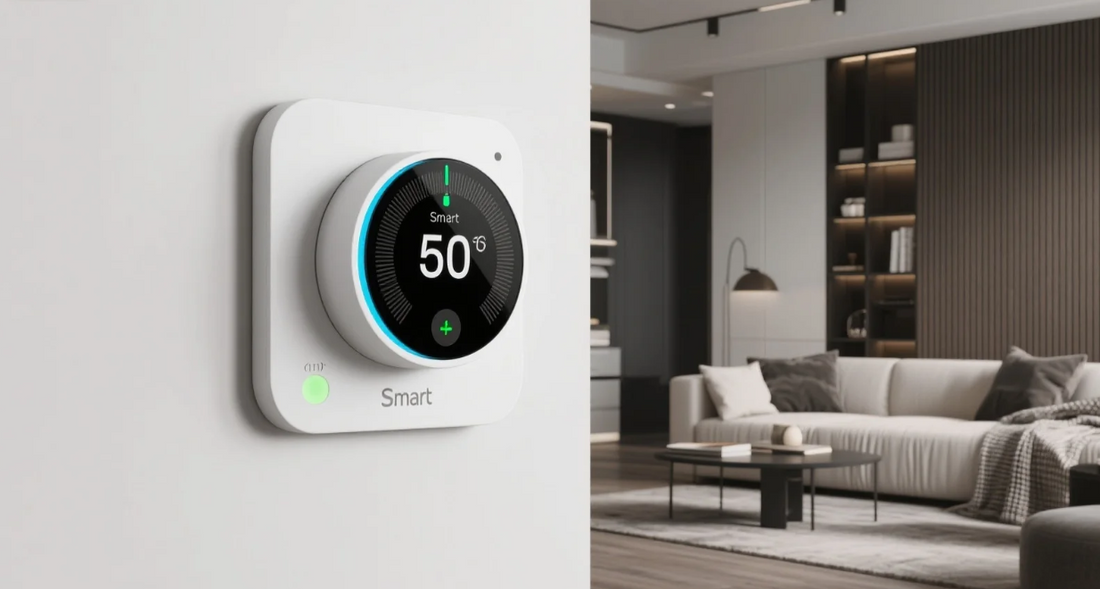
Smart Thermostat Guide: Save Energy & Enhance Comfort
Share
Within the opening lines, homeowners are introduced to the benefits of a smart thermostat, which enables remote operation and energy-efficient control of HVAC systems. Moreover, users are promised valuable insights on how smart thermostats operate, deliver savings, and integrate into smart-home setups. This article is written in a reader-friendly style, featuring structured headings, useful transitions, and professional depth without overusing the keyword.
What Is a Smart Thermostat?

A smart thermostat is a Wi-Fi-enabled device that replaces a traditional thermostat, offering remote control, scheduling, and often advanced automation via smartphones or voice assistants.
Core Benefits for Smart-Home Users
Energy Savings & Automation
These devices learn user habits and adjust heating or cooling when you're away or asleep, delivering significant energy savings. According to ENERGY STAR, average reductions are around 8% on HVAC costs or $50 per year, depending on climate and usage. Other studies show heating savings of 10–12% and cooling savings of 15%. One provider, Duke Energy, even reports up to a 20% annual bill reduction.
Remote & Voice Control
A smart thermostat can be adjusted from anywhere via smartphone apps and supports voice commands through Alexa, Google Assistant, or Siri. It also enables geofencing—automatically detecting when you're away to adjust temperature accordingly.
Learning Behavior & Geofencing
Many units adapt by learning your routines and creating temperature schedules. Some models use motion sensors or geofencing to fine-tune operation, improving comfort and efficiency.
How It Works: Technology Inside

Typically, a smart thermostat is wired into your HVAC system—often requiring a common (C) wire—for continuous power. It uses Wi-Fi to connect to an app or cloud backend, offering features like scheduling, learning routines, and geofencing. More advanced versions analyze occupancy, weather, or user behavior to optimize comfort and savings.
Installation, Compatibility & Setup
Most smart thermostats support common HVAC systems — including conventional heat/cool and heat pumps — but require a C-wire. Installation is often DIY-friendly and takes around 30 minutes. After wiring, the device connects to your home network and guides setup through an app.
Practical Smart-Home Use Cases
Automated HVAC routines: Temperatures adjust based on your schedule or location, ensuring comfort and efficiency.
Integration with smart home systems: Paired with lighting or security, a smart thermostat can participate in coordinated automation—for example, reducing HVAC usage when doors are locked or shades are drawn.
Enhanced environmental control: Some systems detect open windows or use weather data to adjust indoor climate proactively.
Moreover, home automation combining smart thermostats with other connected devices can yield up to 20% reduction in overall energy usage.
Marketing Spotlight: EdgeAnt Smart Thermostat
EdgeAnt’s Wi-Fi smart thermostat, sold at $75 (discounted from $99), offers:
7-day programmable scheduling
Voice control via Alexa & Google Assistant
App control through the Smart Life app
Compatibility with 90% of home HVAC systems (C-wire required)
Features like temperature alerts, filter reminders, time sync, and child lock.
EdgeAnt positions this smart thermostat as an efficient, affordable option for modern homes. In a recent blog post, the EdgeAnt best smart thermostat is promoted as adaptive, energy-saving, and central to a sustainable smart-home experience. Features highlighted include AI personalization, real-time energy reports, sleek touch interface, smart zoning, and upcoming green integrations with solar and biometric security.
Choosing the Right Thermostat for Your Home
Consider these factors:
HVAC compatibility & C-wire requirement
Learning and geofencing capabilities
App usability and voice integration
Energy saving performance and reports
Design, budget, and security features
EdgeAnt offers a cost-effective choice with rich automation and integration features—great for smart-home setups.
Security, Privacy & Best Practices
Since smart thermostats connect to your local network, ensure they offer secure, encrypted Wi-Fi communication and regular firmware updates. Privacy policies should be transparent, particularly when voice or cloud services are involved. For best results, update scheduling and settings periodically, and monitor usage trends to maintain accuracy and efficiency.
FAQ
Q1: Are smart thermostats worth the cost?
Yes—typical annual savings range from 8% to 20% on HVAC bills, depending on usage patterns and climate.
Q2: Do they work with voice assistants?
Yes, many support Alexa, Google Assistant, or Siri for hands-free control.
Q3: What if my home lacks a C-wire?
Some units (like certain EdgeAnt models) require a C-wire. If unavailable, you may need a wiring adapter or professional installation.
Q4: How much can geofencing help?
Geofencing can significantly reduce wasted heating/cooling when you’re away, contributing substantially to energy savings.
Q5: Are smart thermostats secure?
Generally yes—if purchased from reputable brands offering encryption and support. Choose devices with reliable security practices.
Conclusion
A smart thermostat is a powerful tool for enhancing comfort, automating climate control, and cutting energy expenses. With features like learning routines, geofencing, voice voice control, and intelligent scheduling, these devices deliver meaningful value. EdgeAnt stands out as a budget-wise choice offering rich functionality for modern smart homes. Proper setup and security ensure sustainable and smart living.